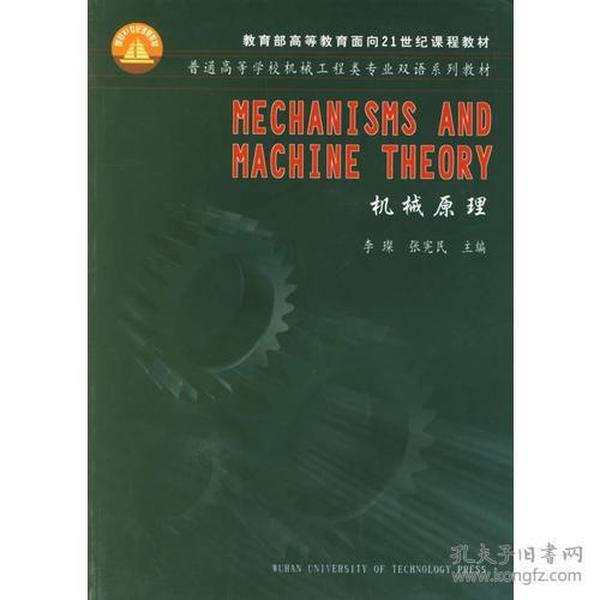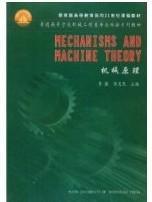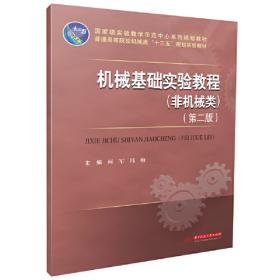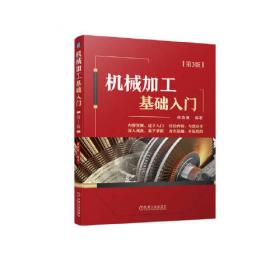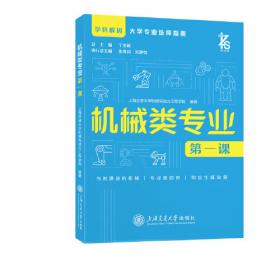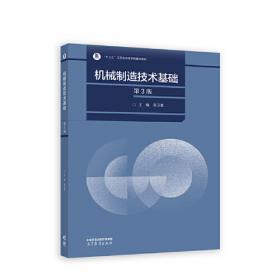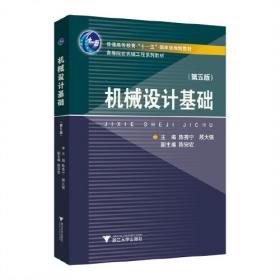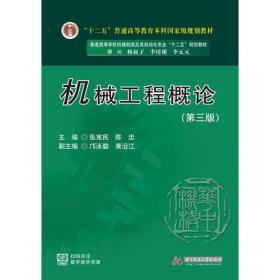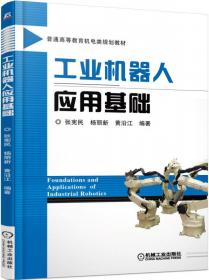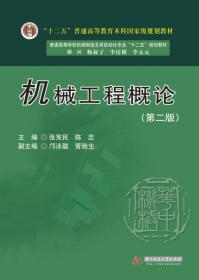机械原理/普通高等学校机械工程类专业双语系列教材
出版时间:
2004-03
版次:
1
ISBN:
9787562920540
定价:
29.50
装帧:
平装
开本:
其他
纸张:
胶版纸
8人买过
-
According to the basic teaching requirements for the course Mechanisms and Machine Theory,and the requirement of bilingual teaching,this textbook is written
for students and teachers of mechanical engineering major in universities and colleges in China.
There are 12 chapters in this textbook:Introduction,Structure Analysis of Me chanisms,Kinematic Analysis of Mechanisms,Friction and Efficiency of Machineries,Planar Linkage Mechanisms,Cams and Their Design,Gears and Their Design,Gear Trains,The Design of Combined Mechanism and Other Common Mechanisms,Machinery Operation and Adjustment of Velocity Fluctuation in Machineries and Balancing. There are some problems and notes at the end of each chapter for students to grasp and practice.
This book can be used as textbook for course Mechanisms and Machine Theory,taught as bilingual teaching material,or be used as textbook for course English in Mechanical Engineering,for students of mechanical engineering major in universitles and colleges. It can also be used as reference book for teachers,students and engineers of mechanical engineering major and other relevant majors. Chapter 1 Introduction
1.1 About this Course
1.2 Mechanisms and Machines
1.3 Content of this Course
1.4 Design Process and this Book
Notes
Chapter 2 Structure Analysis of Mechanisms
2.1 Introduction
2.2 Composition of Mechanisms
2.3 Kinematic Diagrams
2.4 Mechanism with Confirmed Motion
2.5 Number of Degrees of Freedom of the Mechanisms
2.6 Notes when Determine the Number of DOF of Planar Mechanisms
Problems
Notes
Chapter 3 Kinematic Analysis of Mechanisms
3.1 Tasks and Methods of Kinematic Analysis
3.2 Velocity Analysis by the Method of Instantaneous Center
3.3 Kinematic Analysis by Complex Numbers
Problems
Notes
Chapter 4 Friction and Efficiency of Machineries
4.1 Introduction
4.2 Friction in Joints/Kinematic Pairs
4.3 Efficiency of Machineries
4.4 Self-lock of Machineries
Problems
Notes
Chapter 5 Planar Linkage Mechanisms
5.1 Introduction
5.2 The Types of Four-bar Mechanisms and Application
5.3 Characteristics Analysis of Four-bar Linkages
5.4 Synthesis of Four-bar Mechanism
Problems
Notes
Chapter 6 Cams and Their Design
6.1 Introduction
6.2 Cam and Follower Types
6.3 Process of Cam Synthesis
6.4 Displacement Diagrams of Follower
6.5 Graphical Cam Profile Synthesis
6.6 Analytical Cam Profile Synthesis
6.7 Cam Size and Physical Characteristics
Problems
Notes
Chapter 7 Gears and Their Design
7.1 Introduction
7.2 Applications and Types of Gear Mechanisms
7.3 Fundamental Law of Toothed Gearing
7.4 Involute Properties
7.5 Terminology and Definition of Gears
7.6 Involute Geometry
7.7 Mesh and Trains of Involute Spur Gears
7.8 Contact Ratio
7.9 The Forming of Involute Spur Gear
7.10 Interference and Undercutting
7.11 Pofile?shifted Gear
7.12 Helical Gears
7.13 Crossed Helical Gears
7.14 Worm Gearing
7.15 Bevel Gears
Problems
Notes
Chapter 8 Gear Trains
8.1 Introduction
8.2 Ordinary Gear Trains
8.3 Epicyclic Gear Trains
8.4 Compound Gear Trains
8.5 Design of Planetary Gear Trains
8.6 Efficiency of Planetary Gear Trains
Problems
Notes
Chapter 9 The Design of Combined Mechanism and Other Common Mechanisms
9.1 Ratchet Mechanism
9.2 Geneva Wheel
9.3 Intermittent Gearing
9.4 Universal Joint Mechanism
9.5 Combination of Mechanism
Problems
Notes
Chapter 10 Machinery Operation and Adjustment of Velocity Fluctuation in Machineries
10.1 Introduction
10.2 Kinetic Equations of Machinery
10.3 Solution of the Kinematic Equation of Motion
10.4 Flywheels and Periodic Fluctuation of Speed of Machinery Problems
Notes
Chapter 11 Balancing
11.1 Introduction
11.2 Static Balance
11.3 Dynamic Balance
11.4 Balancing of Planar Linkages
Problems
Notes
References
-
内容简介:
According to the basic teaching requirements for the course Mechanisms and Machine Theory,and the requirement of bilingual teaching,this textbook is written
for students and teachers of mechanical engineering major in universities and colleges in China.
There are 12 chapters in this textbook:Introduction,Structure Analysis of Me chanisms,Kinematic Analysis of Mechanisms,Friction and Efficiency of Machineries,Planar Linkage Mechanisms,Cams and Their Design,Gears and Their Design,Gear Trains,The Design of Combined Mechanism and Other Common Mechanisms,Machinery Operation and Adjustment of Velocity Fluctuation in Machineries and Balancing. There are some problems and notes at the end of each chapter for students to grasp and practice.
This book can be used as textbook for course Mechanisms and Machine Theory,taught as bilingual teaching material,or be used as textbook for course English in Mechanical Engineering,for students of mechanical engineering major in universitles and colleges. It can also be used as reference book for teachers,students and engineers of mechanical engineering major and other relevant majors.
-
目录:
Chapter 1 Introduction
1.1 About this Course
1.2 Mechanisms and Machines
1.3 Content of this Course
1.4 Design Process and this Book
Notes
Chapter 2 Structure Analysis of Mechanisms
2.1 Introduction
2.2 Composition of Mechanisms
2.3 Kinematic Diagrams
2.4 Mechanism with Confirmed Motion
2.5 Number of Degrees of Freedom of the Mechanisms
2.6 Notes when Determine the Number of DOF of Planar Mechanisms
Problems
Notes
Chapter 3 Kinematic Analysis of Mechanisms
3.1 Tasks and Methods of Kinematic Analysis
3.2 Velocity Analysis by the Method of Instantaneous Center
3.3 Kinematic Analysis by Complex Numbers
Problems
Notes
Chapter 4 Friction and Efficiency of Machineries
4.1 Introduction
4.2 Friction in Joints/Kinematic Pairs
4.3 Efficiency of Machineries
4.4 Self-lock of Machineries
Problems
Notes
Chapter 5 Planar Linkage Mechanisms
5.1 Introduction
5.2 The Types of Four-bar Mechanisms and Application
5.3 Characteristics Analysis of Four-bar Linkages
5.4 Synthesis of Four-bar Mechanism
Problems
Notes
Chapter 6 Cams and Their Design
6.1 Introduction
6.2 Cam and Follower Types
6.3 Process of Cam Synthesis
6.4 Displacement Diagrams of Follower
6.5 Graphical Cam Profile Synthesis
6.6 Analytical Cam Profile Synthesis
6.7 Cam Size and Physical Characteristics
Problems
Notes
Chapter 7 Gears and Their Design
7.1 Introduction
7.2 Applications and Types of Gear Mechanisms
7.3 Fundamental Law of Toothed Gearing
7.4 Involute Properties
7.5 Terminology and Definition of Gears
7.6 Involute Geometry
7.7 Mesh and Trains of Involute Spur Gears
7.8 Contact Ratio
7.9 The Forming of Involute Spur Gear
7.10 Interference and Undercutting
7.11 Pofile?shifted Gear
7.12 Helical Gears
7.13 Crossed Helical Gears
7.14 Worm Gearing
7.15 Bevel Gears
Problems
Notes
Chapter 8 Gear Trains
8.1 Introduction
8.2 Ordinary Gear Trains
8.3 Epicyclic Gear Trains
8.4 Compound Gear Trains
8.5 Design of Planetary Gear Trains
8.6 Efficiency of Planetary Gear Trains
Problems
Notes
Chapter 9 The Design of Combined Mechanism and Other Common Mechanisms
9.1 Ratchet Mechanism
9.2 Geneva Wheel
9.3 Intermittent Gearing
9.4 Universal Joint Mechanism
9.5 Combination of Mechanism
Problems
Notes
Chapter 10 Machinery Operation and Adjustment of Velocity Fluctuation in Machineries
10.1 Introduction
10.2 Kinetic Equations of Machinery
10.3 Solution of the Kinematic Equation of Motion
10.4 Flywheels and Periodic Fluctuation of Speed of Machinery Problems
Notes
Chapter 11 Balancing
11.1 Introduction
11.2 Static Balance
11.3 Dynamic Balance
11.4 Balancing of Planar Linkages
Problems
Notes
References
查看详情
-
全新
河北省保定市
平均发货19小时
成功完成率73.67%
-
八五品
山东省枣庄市
平均发货8小时
成功完成率88.56%
-
九品
北京市东城区
平均发货25小时
成功完成率89.43%
-
八五品
山东省枣庄市
平均发货9小时
成功完成率87.86%
-
 7
7
八五品
重庆市沙坪坝区
平均发货8小时
成功完成率84.31%
-
八五品
山东省济南市
平均发货8小时
成功完成率94.37%
-
八五品
湖北省咸宁市
平均发货10小时
成功完成率91.45%
-
八五品
湖北省咸宁市
平均发货12小时
成功完成率94.35%
-
八五品
江苏省南京市
平均发货13小时
成功完成率88.04%
-
八五品
福建省福州市
平均发货10小时
成功完成率98.02%
-
九品
四川省成都市
平均发货12小时
成功完成率82.04%
-
八五品
福建省福州市
平均发货5小时
成功完成率94.06%
-
九品
江西省南昌市
平均发货10小时
成功完成率64.29%
-
八五品
福建省福州市
平均发货5小时
成功完成率92.87%
-
八五品
天津市武清区
平均发货13小时
成功完成率94.89%
-
机械原理
正版库存新书☞无阅读划线☞图片与标题不符时以标题为主☞套书售价较底的为单册价。
全新
河北省廊坊市
平均发货9小时
成功完成率89.23%
-
全新
江西省南昌市
平均发货18小时
成功完成率80.94%
-
八五品
重庆市沙坪坝区
平均发货9小时
成功完成率87.32%
-
八五品
上海市黄浦区
平均发货8小时
成功完成率89.03%
-
八五品
上海市黄浦区
平均发货8小时
成功完成率89.03%
-
八五品
江苏省苏州市
平均发货8小时
成功完成率86.59%
-
八五品
江苏省苏州市
平均发货8小时
成功完成率86.59%
-
九品
北京市通州区
平均发货8小时
成功完成率93.28%
-
八五品
山东省滨州市
平均发货17小时
成功完成率83.95%
-
九品
北京市通州区
平均发货8小时
成功完成率92.97%
-
八五品
江西省南昌市
平均发货11小时
成功完成率94.22%
-
八五品
广东省东莞市
平均发货7小时
成功完成率96.46%
-
 2
2
八五品
北京市朝阳区
平均发货11小时
成功完成率96.92%
-
八五品
广东省东莞市
平均发货11小时
成功完成率90.64%
-
九五品
广东省广州市
平均发货5小时
成功完成率91.62%
-
 2
2
九五品
河南省商丘市
平均发货18小时
成功完成率96.34%
-
八品
湖北省武汉市
平均发货7小时
成功完成率90.24%
-
八五品
山东省济南市
平均发货10小时
成功完成率91.81%
-
八五品
福建省福州市
平均发货10小时
成功完成率84.62%
-
八五品
福建省福州市
平均发货9小时
成功完成率87.88%
-
八五品
江西省南昌市
平均发货9小时
成功完成率89.92%
-
九品
广东省东莞市
平均发货9小时
成功完成率83.85%
-
八五品
福建省福州市
平均发货6小时
成功完成率94.41%
-
八五品
江西省南昌市
平均发货9小时
成功完成率93.04%
-
八五品
江苏省南京市
平均发货12小时
成功完成率92.05%
-
九品
江西省南昌市
平均发货12小时
成功完成率90.91%
-
八品
山东省滨州市
平均发货9小时
成功完成率94.05%
-
八五品
甘肃省兰州市
平均发货6小时
成功完成率90.31%
-
九品
湖南省长沙市
平均发货8小时
成功完成率91.92%
-
八五品
湖北省咸宁市
平均发货6小时
成功完成率96.35%
-
九品
山东省日照市
平均发货16小时
成功完成率76.62%
-
全新
北京市东城区
平均发货21小时
成功完成率85.55%
-
机械原理
下单之前仔细阅读商品详情,发货按照标题书名和书号为准,图片仅供参考。套装超重需补运费。
全新
河北省保定市
平均发货18小时
成功完成率83.91%
-
八五品
甘肃省兰州市
平均发货6小时
成功完成率79.34%
-
八五品
山东省滨州市
平均发货9小时
成功完成率96.09%

 占位居中
占位居中



